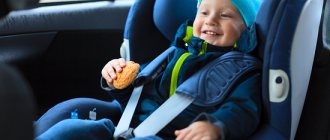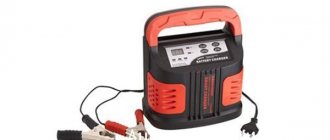All over the world, children's car seats are divided into groups according to the weight and height of the child. This classification is reflected in the European standards ECE 44 or ECE 129 (i-Size), which are also supported by the Technical Regulations of the EAEU Customs Union. Dividing into groups allows you to select a model in accordance with the age of the child.
| Group | Weight, kg | Approximate age |
| 0 | 0-10 | from birth to 6 months |
| 0+ | 0-13 | from birth to 1 year |
| 1 | 9-18 | from 9 months to 4 years |
| 2 | 15-25 | from 3 to 7 years |
| 3 | 22-36 | from 6 to 12 years |
Combined groups
There are car seats that combine the functions of several groups at once. Such seats are convenient when moving from one group to another, when the child in the seat of one group has already grown up, but is still too small for the other. As a rule, buying a universal seat is cheaper than car seats of 0, 1, 2 and 3 groups separately.
The following groups are most often combined:
| Group | Weight, kg | Approximate age |
| 0+1 | 0-18 | from birth to 4 years |
| 0+1-2 | 0-25 | from birth to 7 years |
| 1-2 | 9-25 | from 1 year to 7 years |
| 1-2-3 | 9-36 | from 1 year to 12 years |
| 2-3 | 15-36 | from 3 to 12 years |
To accurately select the right car seat group, use the table of the approximate weight and height of the child depending on his age.
Age groups of child car seats
Which age group of child car seat should you choose for your child? At the moment, there are 4 main age groups, which occur both separately and in combination. And it can be quite difficult for a non-specialist to understand them. We have collected descriptions of the main ones in this article.
Group 0+
These are chairs that are purchased for a newborn, the so-called carrying chairs. Typically, such car seats are designed for children from birth to 12-15 months and up to a weight of 13 kg. In a car, seats 0+ are installed exclusively “backward forward”, facing the direction of travel. All models can be secured with a car seat belt, but it is preferable to use them with an ISOFIX base, which eliminates the risk of incorrect fastening and makes the seat easier to use.
Important! The position of the child in the 0+ seat on the car seat is far from horizontal and this is normal! The child is positioned in a natural position, but his back is at a certain angle to the direction of movement
A child 0+ is secured with 3 or 5 point internal straps (in this group the difference is not fundamental). An obvious advantage of the carriers: they are compact and quite light. However, they are most convenient when paired with a compatible stroller as a chassis. In addition to 0+, there is also group 0 - car seats similar to a stroller cradle, with installation across the rear seats, but this solution is not popular due to obvious disadvantages with safety, dimensions and short lifespan.
Important! Installation of seat 0+ is only allowed when the front airbag is disabled.
Group 0+1
Chairs 0+/1 from birth (or from 3-6 months) to 4 years, up to 18 kg.
All the safest modern chairs for children under 4 years of age are concentrated in 0+1. First of all, these are seats developed in accordance with the new standard R129 (I-SIZE) with ISOFIX fastening and the ability to transport a child “backward forward” for as long as possible and having more spacious interior space. The 0+1 chair can have a swivel mechanism - when the seat of a fixed chair can be turned to the side for more convenient boarding/disembarking of the child. As a third attachment point, 0+1 chairs with ISOFIX use a sliding floor rest, or, less commonly, a TopTether anchor belt.
The child is fastened with a five-point internal harness.
Important! When choosing a car seat for a child from 9 months to 2 years, not a single seat of groups 1, 1-2, 1-2-3 can compare in safety with 0+1 I-Size installed rear-facing, even if the rating in crash tests they are the same! Ratings are made to compare seats from the same age group, and the rear-facing seat allows the child to withstand much greater loads in the event of a frontal impact or emergency braking of the car.
Car seats for this age group can be of two standards - R44/04 or the newer and more modern I-SIZE. The main differences in the standards: I-SIZE - the chair can only be installed on ISOFIX + auxiliary support in the floor or anchor mount. It is possible to transport the child “backwards forward” throughout the entire period of operation. R44/04 – the seat can be secured with a belt or ISOFIX + auxiliary support to the floor or anchor fastening. Rear-facing transportation is almost always limited to only up to 13 kg, approximately 9-12 months.
Group 1
Group 1 chairs from approximately 1 year to 4 years, up to 18 kg, with installation only in the direction of travel.
All chairs in this group have a good recline position, which distinguishes them from most universal chairs. The minimum age of a child according to standard R44/04 is 9 months, according to the new standard R129 I-Size - 15 months. There are models with ISOFIX fastening, with fastening with a seat belt, and less often - with both of these fastening methods at once.
Group 1 seats with ISOFIX use a Top Tether or sliding floor support as a third anchorage point. The child is fastened with a five-point harness or a so-called “safety seat”.
Group 1-2-3
A very popular group is 1-2-3, universal car seats 9-36 kg, with the greatest variety of designs and mounting methods. Nominally, chairs in this group are designed for ages from 9 months to 12 years, but we do not recommend such chairs for children under 12 months, both for safety and comfort reasons.
The main advantage of these chairs is their versatility and long service life. They will last at least 7-8 years, and some models up to 11 years.
Most models of group 1-2-3 are inferior to groups 0+1 and 1 either in safety, or in comfort, or in both criteria, but there are exceptions.
Group 2-3
Chairs from 3-4 to 12 years, for children with a height of 95-100 cm, from 15 to 36 kg. The most important criterion for starting to use a seat 2-3 is that the child’s height is at least 95, and better yet, 100 cm. The maximum height of a child for which car seats are usually designed is 140-150 cm.
Note! In all seats of this age group, the child is secured in the car seat with a standard car seat belt
The child begins to buckle up in almost the same way as an adult passenger; the seat only positions the seat belt correctly and provides side impact protection.
In the event of a frontal impact, the seat accompanies the child until the seat belt is activated. There are many models in this group that are attached to the car’s IsoFix system, while the seat is installed more rigidly and securely. Soft Latch fastening is also often used - fastening with straps with carabiners. At the same time, only the lower part of the seat is attached; the back of the child seat reclines freely on the car seat and is not fixed in any way.
Seats 2-3 with one or another mounting option for ISOFIX, you can always attach them with a seat belt - for example, in a car without ISOFIX or in the front seat
Groups 0-1-2 0-1-2-3 and 1-2
Various variations of combining age groups. Allows you to select the optimal child car seat for the period of use. The main advantage is a very long period of use. For example, by purchasing one 0-1-2-3 seat, it will replace all the child car seats that the child will need until the moment when he can already ride as an adult.
All children's car seats that can be purchased in the Avtokresel.net catalog comply with modern standards and significantly exceed them.
Age, weight and height appropriate for boys
| Age | Weight, kg | Height, cm |
| 1 month | 4,3 | 54 |
| 2 months | 5,1 | 57 |
| 3 months | 5,8 | 60 |
| 4 months | 6,6 | 63 |
| 5 months | 7,2 | 66 |
| permissible difference | +/- 0,8 | +/- 4 |
| 6 months | 7,9 | 68 |
| 7 months | 8,4 | 70 |
| 8 months | 8,8 | 72 |
| 9 months | 9,2 | 73 |
| 10 months | 9,7 | 74 |
| 11 months | 10,2 | 75 |
| permissible difference | +/- 1,5 | +/- 4 |
| 12 months | 10,4 | 76 |
| 1.5 years | 11,6 | 82 |
| 2 years | 12,7 | 88 |
| 2.5 years | 13,7 | 93 |
| permissible difference | +/- 2,5 | +/- 6 |
| 3 years | 14,7 | 97 |
| 3.5 years | 15,6 | 101 |
| 4 years | 17 | 105 |
| permissible difference | +/- 3 | +/- 7 |
| 4.5 years | 17,8 | 108 |
| 5 years | 19,2 | 112 |
| permissible difference | +/- 3,5 | — |
How to choose a child car seat for a child: groups of seats
To ensure that children of different ages feel comfortable and safe in a car seat, manufacturers have come up with a division into groups. Here is a table for choosing a child seat - first of all, focus on the age group, and then check the weight. For example, children 7 months old usually weigh about 8 kg - the chair will be in the “0+” group.
| Group | Age | Weight, kg |
| Group 0 | 0-6 months | 0-10 |
| Group 0+ | 0-12 months | 0-13 |
| Group 1 | 9 months - 4 years | 9-18 |
| Group 2 | 3-7 years | 15-25 |
| Group 3 | 7-12 years | 22-36 |
Age, weight and height appropriate for girls
| Age | Weight, kg | Height, cm |
| 1 month | 4,1 | 53 |
| 2 months | 4,8 | 56 |
| 3 months | 5,4 | 59 |
| 4 months | 6 | 62 |
| 5 months | 6,7 | 64 |
| permissible difference | +/- 0,8 | +/- 4 |
| 6 months | 7,4 | 66 |
| 7 months | 8 | 68 |
| 8 months | 8,5 | 70 |
| 9 months | 8,9 | 72 |
| 10 months | 9,3 | 73 |
| 11 months | 9,6 | 74 |
| permissible difference | +/- 1,5 | +/- 4 |
| 12 months | 9,8 | 75 |
| 1.5 years | 11,1 | 81 |
| 2 years | 12,2 | 88 |
| 2.5 years | 13,3 | 91 |
| permissible difference | +/- 2,5 | +/- 6 |
| 3 years | 14,3 | 96 |
| 3.5 years | 15,2 | 100 |
| 4 years | 16,5 | 104 |
| permissible difference | +/- 3 | +/- 7 |
| 4.5 years | 17,4 | 107 |
| 5 years | 18,6 | 111 |
| permissible difference | +/- 3,5 | — |
Rate this page
3.8 / 130
How to choose a car seat for a child
Group 0 car seats are intended for the smallest children from newborn to six months, and weighing up to 10 kilograms. Such chairs are a small cradle where the child is in a lying position. The cradle is installed on the rear seat sideways in relation to the direction of travel. The baby is secured in the cradle with wide straps. The seat itself is secured either with standard seat belts or with special fasteners. Group 0+ car seats are designed for children from birth to approximately one year old (0-13 kg). Such seats are a cup-shaped structure (a transitional link between an infant carrier and a car seat), which is installed on the rear or front seat facing the direction of travel. This installation method is necessary in order not to load the fragile children’s spine and to avoid injuries when braking. Such a chair is usually equipped with a soft lining under the back, as well as handles for easy carrying, which is why their second name comes from “carrying”.
Group 1 car seats allow you to transport babies aged from 9 months to 4 years. This seat looks similar to a standard car seat and is installed in the direction of travel of the car. The car seat is usually equipped with three- or five-point internal seat belts and a system for adjusting the backrest position (sitting or lying down). This chair is designed to last for several years of use by a growing child until he reaches a weight of about 18 kg.
Group 2 car seats are intended for children aged 3 to 7 years; they are also installed in the direction of travel. Seats in this group are often equipped with a backrest height adjustment system so that it can be adjusted to the height of the child. Or the backrest can be removed altogether, thereby turning the chair into a group 3 model.
Group 3 car seats, so-called “boosters”, are designed for children from 6 to 12 years old. These seats are a backless seat that raises the child to a height sufficient for him to use standard seat belts. But it should be noted that such seats do not fully meet all safety requirements for transporting children, since they do not have side protection.
A car seat for children can correspond to two or three groups at once; such models are called universal. Manufacturers most often combine car seats of the following groups: Group 0+/1 (0-18 kg) – for children from 6 months to approximately 4 years. For the first year and a half of a baby’s life, the car seat is installed in the rear-facing direction, and after that – in the forward-facing direction. Group 2/3 (15-36 kg) – for children aged 3 to 12 years. Group 1/2/3 (9-36 kg) – the most universal group, designed for children from 9 months to 12 years.
Combined groups 0+/1, 0+/1/2, 0/1/2/3
Chairs of category 0+ are intended for children weighing up to 13 kg. There are also chairs for sale in a combined group 0+/1, designed for a weight of up to 18 kg. But they tend to be very large for babies, and even soft inserts do not always compensate for too much space. In addition, the child is in such a chair in a semi-sitting position, which is bad for newborns. So if you really use such devices, then only when the child learns to sit. At the same time, long trips should be avoided to reduce the load on the spine.
Universal chairs (combined groups) are usually quite bulky, expensive and not always comfortable for a child.
Universal chairs (combined groups) are usually quite bulky, expensive and not always comfortable for a child.
This is especially true for seats in combined groups 0+/1/2 and 0+/1/2/3. Yes, there are some. The former are designed for weights from 2.2 to 30 kg, the latter - from 2.2 to 55 kg. Wow range! Of course, it is tempting to buy one car seat for your entire childhood, rather than changing it every couple of years. But, firstly, such a chair will initially be very large for the child, despite all the inserts, and then it may turn out to be too small (in short, for example, the legs will hang in the air). Both are bad, the chair should be “fitted.” Secondly, before purchasing, the model you like must be checked for compliance with safety standards. After all, the chair is bought specifically to ensure the safety of the child. Ratings you can trust - for example, the German automobile club ADAC. The Germans annually conduct crash tests of current models of child seats. Unfortunately, not all models presented on the Russian market are included in these ratings. And thirdly, universal chairs are very expensive - despite the nuances mentioned above.











